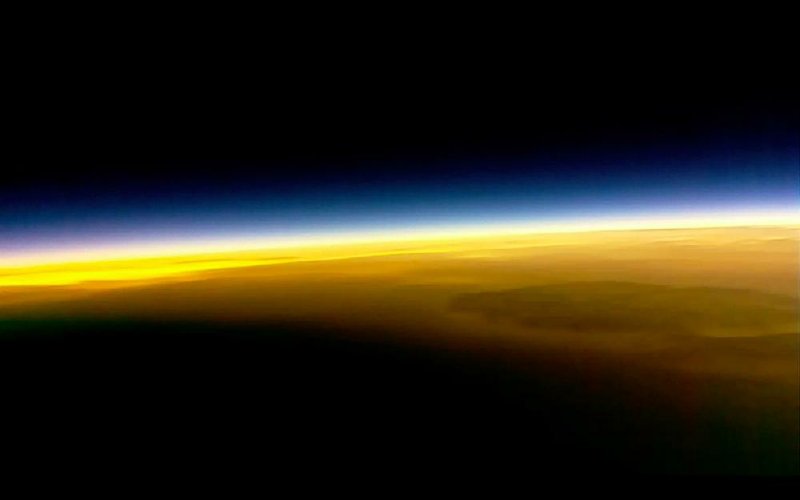Arkansas researchers were successful in their mission to shoot video of Monday's total solar eclipse from cameras underneath a helium-filled weather balloon 15 miles above Fulton, Mo.
But on Monday, they weren't so sure.
An electrical glitch had severed the livestream to NASA, and the parachuted payload carrying seven cameras landed in a creek about 50 miles from the launch site.
Precautions had been taken in case of a splash landing.
The camera equipment was encased in foam board, waterproof glue and tape, so everything was fine, said James Tillman Kennon, associate chairman of the chemistry and physics department at Arkansas State University in Jonesboro and a professor of science education.
Floating foam pool noodles hung from the payload like streamers from a fishing lure in case it landed in a lake.
On Tuesday and Wednesday, the Arkansas researchers were busy viewing the results of the mission.
"Stop what you're doing and watch this video. We did it!" Ross Carroll, assistant professor of physics at ASU, emailed to other researchers Tuesday.
Ed Roberts, a physics teacher at Pottsville High School, said they were "extremely excited" about the results.
"It's exceeding our expectations without a doubt," he said.
The researchers were part of Arkansas BalloonSat, which stands for balloon satellite. Based at ASU, Arkansas BalloonSat was one of 55 high-altitude ballooning teams across the United States that filmed Monday's eclipse for NASA.
Roberts and Kennon manage Arkansas BalloonSat, which Roberts founded in 2006 at the request of NASA. Monday's project was the 50th launch for Arkansas BalloonSat.
[COUNTDOWN: How much time is left until 2024 eclipse? ]
Seven ASU students, six from Pottsville High School and one from the University of Central Arkansas assisted with the balloon launch Monday.
About 10 minutes of Arkansas BalloonSat's raw video was posted online at youtu.be/jYj7MdzRlHU.
The moon's shadow can be seen moving across the clouds and Earth.
Roberts said efforts have been made to construct the payload so it doesn't occasionally spin in the wind, but "We don't have any control over that."
The nationwide Eclipse Ballooning Project was coordinated by Montana State University. The primary goal of the project is to provide a unique perspective of the eclipse by livestreaming aerial video of the celestial event from the edge of space to NASA's website for a worldwide audience, according to www.coe.montana.edu/eclipse/media.html. The images taken by the cameras will help scientists better understand the atmospheric effects of the eclipse, according to the website.
Marshall Swearingen, a spokesman for Montana State, said his university's livestream didn't work Monday either. Swearingen said he's not sure what went wrong, but there was an increase in radio noise that researchers think was a factor.
The teams were still posting video and still photographs on the website Wednesday, he said. That will likely continue throughout the week.
The eclipse cut a 70-mile-wide swath of total darkness from Oregon to South Carolina. The path of total eclipse included central Missouri, southern Illinois and central Tennessee, all of which are a relatively short driving distance for Arkansas residents. The maximum duration of total darkness was 2 minutes and 40 seconds in Carbondale, Ill.
It was the first total solar eclipse to cross the continental United States since 1918, and the first one visible anywhere in the continental U.S. since 1979.
The entire North American continent experienced a partial eclipse Monday.
Clouds rolled over Fulton, Mo., just before the total eclipse, but that didn't dampen the spectacle for those on the ground. The duration of the total eclipse in Fulton was 2 minutes and 34 seconds as the moon's shadow raced across Missouri at about 1,500 mph.
The Arkansas BalloonSat team was set up at the football field at Fulton High School.
A smoldering motor in an air transfer unit in the duct system at the school apparently caused a problem with the Wi-Fi, said Superintendent Jacque Cowherd. The air transfer system shut down, reset itself and restarted, he said.
When that happened, the Wi-Fi connection was lost, severing the livestream to NASA.
The balloon reached an altitude of 79,761 feet before it burst, and a parachute opened to carry the payload back to Earth, said Patrick Tribbett, an ASU senior physics major from Kingman, Ariz.
The payload landed in a creek near Truxton, Mo., about 50 miles northeast of Fulton.
NASA reported that 4.4 million people were watching its television coverage midway through the eclipse, the biggest livestream event in the space agency's history. The livestream also was broadcast on NASA's website at http://eclipse.stream.live.
Arkansas will experience a total solar eclipse in 2024.
Metro on 08/24/2017
